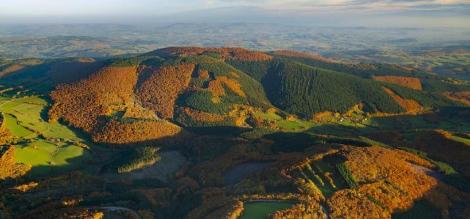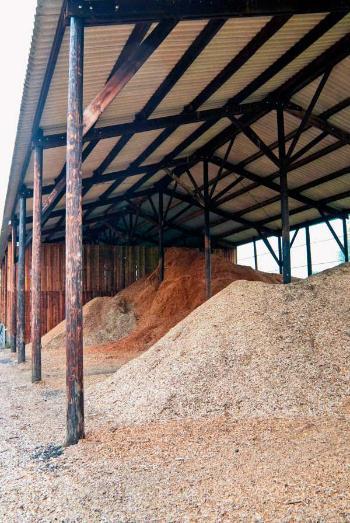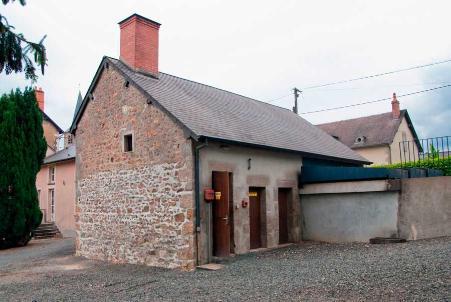Biomass on Mount Beuvray
Chaire Paysage et énergie (ENSP), 2022
The Bibracte archaeological site and its museum are located at the top of Mount Beuvray in Burgundy, in the Morvan Regional Nature Park on the borders of the Nièvre and Saône-et-Loire departments. Bibracte has been awarded the Grand Site label since 2008, and in September 2022 it will be positioned as « a territorial laboratory for ecological and solidarity-based transition within the Morvan Regional Nature Park » (www.bibracte.fr). This development has been possible thanks to the guidelines chosen by the site and the Morvan Regional Nature Park, particularly in terms of developing the resources resulting from the management dynamics of the wooded heritage of Bibracte and the surrounding area, and the products resulting from forestry.
To download : guide_transuition_energetique-biomasse_mont_beuvray.pdf (220 KiB)
The Bibracte archaeological site in the heart of a diversity of forest massifs

1 - Mountains, wet valleys and woodlands
The Bibracte archaeological site and its museum are located at the top of Mount Beuvray in Burgundy, in the Morvan Regional Nature Park on the borders of the Nièvre and Saône-et-Loire departments. The territory is mainly occupied by forest, developing densely, with varied exposures, on acidic soil and in places on steep slopes. Farming is mainly concentrated on livestock, forming a bocage that tends to shrink with the advance of the woodland cover, particularly at the bottom of the valleys. Rainfall is abundant and the Beuvray reacts like a sponge, distributing water through about fifteen springs and numerous valleys.
2 - The Morvan, stories of habitat and forest
Bibracte is a Gallic oppidum, a fortified town built on a hilltop, dating from the 1st century BC. The ancient city fulfilled important economic, political and religious functions and was the capital of the Aedui. Within the oppidum, the public places were established in connection with the large geographical features. For example, the forum was located on a pass, and all the axes of its entrances followed valleys. The site is of remarkable archaeological value. As the town was abandoned after the Roman conquest and not rebuilt, the excavations directly reveal buildings from the 1st century BC. Bibracte is thus a major site of the Iron Age in Europe.
The archaeological discoveries reveal the extent to which life in the Gaulish period was marked by the use of wood. The exploitation of wood was important for building dwellings, supplying forges and heating systems.
3 - National influence of the wood industry and changes in the forest
In modern times, the use of wood from the Morvan spread as far as Paris, and this changed the landscape. In the 18th century, the capital had 250,000 inhabitants. The population quadrupled to 1 million in 1846. It was then heated entirely by wood (until 1850 with the development of coal). The Morvan provided three quarters of its wood resources. The population of the Morvan reached its peak in the middle of the 19th century. The wood was transported to Paris by floating on the Yonne from Clamecy and then on the Seine. The exploitation of the Morvan massif for the capital changed the forest. The forest, an ecosystem consisting of a high forest with tall trees intended to be felled for the exploitation of the wood obtained, is gradually being replaced by a coppice, a stand of deciduous trees stemming from the stumps. Intensive logging has also impoverished the beech forests. In the middle of the 20th century, the plantation of conifers to regenerate this overexploited forest made its appearance, with plantations of spruce and then Douglas fir.
4 - Dark forest, landscape closure and global warming
The balance between forestry, agriculture and economic production was upset at the beginning of the 20th century with the start of the agricultural decline and the introduction of forest cover, as well as the change in the way in which agriculture and forestry were run. The large agricultural areas of the 19th century were left to fallow; the grazed bocage became less important, and the intensive production forest gradually closed in the mountain and valley landscapes. The softwood forests of the Morvan produce a lot and export throughout France. The views and perspectives on the distance are becoming rare and important places to preserve. Today, the forest is largely exploited, but episodes of drought are reducing the water resources. In addition, various pests endanger these forests, which have become fragile due to their monospecific nature. It is in this sensitive context that the wood-fired heating projects exploiting the resources of Mount Bibracte were born, attempting both to enhance the archaeological and geomorphological site and to improve the management of the forests with a view to forest sustainability.
The main stages in the development of the timber industry and forest landscapes
1 - The landscape and the magic of the place: the archaeological site, immersed under a centuries-old forest
In 2004, the landscape designer Claude Chazelle produced a master plan for the Mont Beuvray site commissioned by the Ministry of Culture’s Architecture and Heritage Department in partnership with Bibracte. This report was used for Bibracte’s application for the Grand Site de France label. The landscape architect now advises the Bibracte public cultural cooperation establishment (EPCC), which has managed the archaeological site and its museum since 2007. The landscape study highlighted the importance of forest management for the archaeological interpretation of the site. Indeed, the archaeological traces are modest (most of the town’s buildings were made of wood). The archaeological remains are revealed by enhancing the geomorphology of the site.
Three principles have been adopted:
-
To make the geography of the space that serves as a receptacle for the town perceptible (high points, valleys, relationships with the surrounding hills and valleys)
-
Differentiate the ancient city from its geographical support (the wooded massif of Mount Beuvray)
-
Better assert the site’s locations, including those where the remains can be viewed by the public.
2 - Energy from biomass from the forest
The energy approach was secondary in the development of the project. It stemmed from the overall management of the woodland heritage of Bibracte and the surrounding area, with a view to developing the products of forestry operations, which until now have had no outlet. The successful trial of a communal wood chip boiler in the commune of Millay served as an example for Bibracte. In 2007, the EPCC installed the first wood-fired boiler for the Bibracte Museum. The financial aspect was a driving force behind the project: the museum was a major consumer of fuel oil (approximately 55,000 litres per year). The increase in the price per litre in the 2000s had an impact on the operating budget.
The installation had a leverage effect. In 2014, the commune of Glux-en-Glenne installed its communal boiler, which also supplies the Bibracte archaeological research centre and subsequently various buildings in the commune and on the Bibracte site. The commune has also improved the insulation of its buildings as part of an energy saving certificate scheme (CEE), with the renovation of around fifty windows and skylights.
Wood (landscape and fragment) as a common resource: shared energy management
1 - Joint management of the forest estate and landscape
The Bibracte EPCC manages a forest estate of 950 ha by delegation from the State for 800 ha and the Morvan Regional Nature Park for 150 ha. The Office National des Forêts (ONF) is associated with the EPCC as a technical operator providing know-how and expertise. A management plan is established for 25 years. To ensure the quality of the site’s forest management, the EPCC has turned to two labelled certifications. Certification of the massif under the PEFC (Program for the Endorsement of Forest Certification schemes) and FSC (Forest Stewardship Council) labels. Six owners: the EPCC, the PNR, the Department of Nièvre, the town of Autun and the Conservatoire des espaces naturels de Bourgogne have joined forces within the association Groupe d’Histoire des Forêts Françaises (GHFF) to bear the costs of the audit and to promote responsible management of the forest, by attesting to the quality of the stands, the quality of exploitation and the monitoring of afforestation.
2 - Selected evolution of the forest landscape
The management of the forest estate is based on the desire to diversify the woodlands. The forestry management aims to irregularise the monospecific coniferous stands in terms of species, with the re-introduction of broadleaved trees. Thinning is carried out every 7 to 10 years inside the ramparts of the Bibracte oppidum, and every 5 years outside. Maintenance is carried out by the ONF and productive felling by external service providers. The income from wood production is used to maintain the site. A foot by foot management of the trees is preferred inside the ramparts. The forestry management of the massif tends to promote silvicultural know-how and to provide local proof of a more adapted silviculture that is aware of current issues: choice of species, type of cutting, soil management, etc.
3 - Landscapes and energy resources at risk
The forest remains a fragile ecosystem. The last few years of water stress experienced by the region have greatly weakened the stands. Since the drought of 2003, trees have shown symptoms due to the lack of water. Frequent epidemics of bark beetles, which burrow under the bark of spruce trees, have forced the ONF to carry out sanitary clear-cuts on 95 ha over the last five years. These clear-cuts invite us to rethink the planting and management of woodlands on the plots concerned, by integrating the potential of the energy sector.
Architectures and locations of the wood energy sector

The local sector is materialised by two wood boilers. The first boiler room supplies the archaeological museum. It is a closed circuit boiler located in the basement of the museum, invisible from the outside. The wood chips are transported by Bibracte’s technical services. The second boiler is located in the town of Glux-en-Glenne. It takes the form of a small building near a parking area and in continuity with the houses. It is not very visible. The EPCC used the recommendations of the Claude Chazelle study to determine the site. The landscape architect was regularly consulted during the reflection process and validated the final choices.
Another feature of the project is the storage building, which is shared with the commune’s technical room. It is located upstream from the village in the hamlet of Echenault. It follows the shape of the hamlet’s buildings and their orientation. It allows for the storage of wood, shredding by an external partner and the storage of the shredded material. Its location has been thought out with the landscape architect and the NRP. However, the desire to use local materials failed, as no sawmill offers wood for the cladding.
The storage of the wood before grinding was installed in five clearings on easily accessible parts of the foothills of Mont Beuvray, between the archaeological centre and the museum.
The wood chipped for the chips comes exclusively from the forest massifs of Mont Beuvray located 4 km from the chip shed.
Bibracte and Millay, pilot examples of the Morvan’s woodchip heating systems

The commune of Millay was the first commune in the Morvan to equip itself with a wood chip heating system in 1988, and it was also the first collective heating system to heat collective buildings. The Economic Interest Grouping (EIG) of Millay wood producers was created in 1992 to produce wood chips.
« The supply of Millay’s boiler rooms by the GIE makes it possible to lay the foundations of a local and sustainable sector. Wood Energy in the Morvan, PNR Morvan, May 2018
The municipality of Millay thus became a model for the region. In 1999, the town of Autun commissioned an 8 MW boiler to replace two oil-fired boilers. Connected to the city’s urban heating network and operating from October to May, it currently covers 70% of needs, i.e. 3,500 homes. Four jobs have been created: three in logistics and one in maintenance.
The Morvan Regional Nature Park has been supporting these initiatives since the 1990s and appointed a renewable energy officer in 2002. Since then, the number of boiler rooms has continued to grow. Since 2008, the NRP has been working on the possibility for communes to delegate to the departmental energy union the competence to create and manage a wood heating network to facilitate the installation of boilers for small communes. The NRP now has about sixty communal wood-fired boilers and the network covers a quarter of the Park’s communes.
Today, the park is looking to optimise existing installations and extend networks such as the one in Glux-en-Glenne. The ADEME and the Burgundy-Franche-Comté region provide partial funding for these installations.
Sources
Experience extracted from the guide « Energy transition: towards desirable landscapes » produced in 2021 - 2022 by the Landscape and Energy Chair of the Ecole Nationale Supérieure du Paysage de Versailles: www.ecole-paysage.fr/fr/node/402